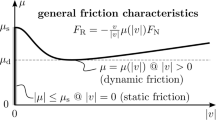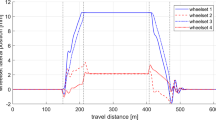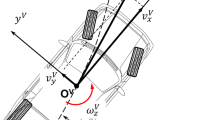Abstract
Impacts, friction, and normal contact forces occur in the railway vehicles couplers. This paper presents a novel nonsmooth model of the train collision; until now, only penalized models have been approached. The train dynamics is described by an equality of measures formulated at the velocity level. The equations of motion are integrated using the Moreau time-stepping algorithm. Impulsive and normal contact forces are described by a set-valued law of Signorini type, while friction forces are described by a set-valued law of Coulomb type. The constrained forces are computed deducing a particular, simplified formulation of the Udwadia–Kalaba equations. The resulting algorithm is simple and straightforward. Both impulsive and nonimpulsive dynamics are casted in the same framework. Any feature or situation regarding train collisions may be modeled. A demonstrative application is presented. Simulations reveal nonsmooth phenomena like simultaneous multiple collisions, stick-slip, captures, and offset in the final equilibrium position.








Similar content being viewed by others
References
Cole, C.: Longitudinal train dynamics. In: Handbook of Railway Vehicle Dynamics. CRC/Taylor & Francis, Boca Raton, London (2006)
Ansari, M., Esmailzadeh, E., Younesian, D.: Longitudinal dynamics of freight trains. Int. J. Heavy Veh. Syst. 16(1/2), 102–131 (2009)
Cole, C.: Improvements to wagon connection modelling for longitudinal train simulation. In: Conference on Railway Engineering, Institution of Engineers, Australia, pp. 187–194 (1998)
Cantone, L., Karbstein, R., Müller, L., Negretti, D., Tione, R., Geißler, H.-J.: TrainDynamic simulation—a new approach. In: WCRR 2008—8th World Congress on Railway Research, Seoul, Korea (2008)
Cruceanu, C., Oprea, R., Spiroiu, M., Craciun, C., Arsene, S.: Computer aided study regarding the influence of filling characteristics on the longitudinal reaction within the body of a braked train. In: Recent Advances in Computers—Proceedings of the 13-th Int. Conf. on Computers, Rhodos, Greece, pp. 531–537. WSAS Press, Washington (2009)
Cruceanu, C., Oprea, R., Spiroiu, M., Craciun, C., Arsene, S.: A model for the dynamic longitudinal reactions in the body of a braked passenger train. In: Proceedings of the 2009 Int. Conf. on Sci. Com. WORLDCOMP’09, pp. 58–64. CSREA Press, Las Vegas (2009)
Lifen, D., Jilong, X., Zhanxun, S.: Research on the effect of buffer’s properties on train longitudinal impact. In: ICIC ’09 Proceedings of the 2009 Second International Conference on Information and Computing Science. vol. 04, pp. 252–255 (2009)
Lifen, D., Jilong, X.: Research on the effect of traction tonnage on train longitudinal impact. Key Eng. Mater. 450, 466–469 (2010)
Muller, L., Witt, T.: TRAIN—a computer model for the simulation of longitudinal dynamics trains. In: Conference on Railway Engineering, Rockhampton, Institution of Engineers, Australia, pp. 181–186 (1998)
Pugi, L., Fioravanti, D., Rindi, A.: Modelling the longitudinal dynamics of long freight trains during the braking phase. In: 12th IFToMM World Congress, Besançon, France, 18–21 June 2007
Grabner, G., Kecskemethy, A.: Dynamic simulation of colliding trains for buffer stop dimensioning. Proc. Appl. Math. Mech. 3, 156–157 (2003)
Kulkarni, V.: Dynamic analysis of high speed rail-vehicle collisions. In: IMAC-XXIV: Conference & Exposition on Structural Dynamics (2006)
Yasushi, U., Tomohiro, O., Koji, F.: Application on multi body dynamics simulation for train crash analysis. Nihon Kikai Gakkai Nenji Taikai Koen Ronbunshu 7, 123–124 (2006)
Priante, M., Tyrell, D., Perlman, B.: A collision dynamics model of a multi-level train. In: ASME 2006 International Mechanical Engineering Congress and Exposition, pp. 25–34 (2006)
Nemeth, I., Kovacs, K., Reimerdes, H.G., Zobory, I.: Crashworthiness study of railway vehicles–developing of crash elements. In: 8th Mini Conference on Vehicle System Dynamics, Identification and Anomalies, Budapest, 11–13 Nov. 2002
Thomsen, P.G., True, H. (eds.): Non-Smooth Problems in Vehicle System Dynamics. Springer, Berlin (2010)
Baraff, D.: Analytical methods for dynamic simulation of non-penetrating rigid bodies. Comput. Graph. 23(3), 223–232 (1989)
Moreau, J.J.: Unilateral contact and dry friction in finite freedom dynamics. In: Moreau, J.J., Panagiotopoulos, P.D. (eds.) Non-Smooth Mechanics and Applications. CISM Courses and Lectures, vol. 302, pp. 1–82. Springer, Wien (1988)
Ivanov, A.P.: On multiple impact. J. Appl. Math. Mech. 59(6), 887–902 (2006)
Chaterjee, A., Ruina, A.: A new algebraic rigid-body collision law based on impulse space considerations. J. Appl. Mech. 65(4) (1998)
Acary, V., Brogliato, B.: Numerical methods for nonsmooth dynamical systems. In: Lecture Notes in Applied and Computational Mechanics, vol. 35. Springer, Berlin, Heidelberg (2008)
Glocker, C.: Set-valued force laws: dynamics of non-smooth systems. In: Pffeifer, P. (ed.) Lecture Notes in Applied Mechanics, vol. 1. Springer, Berlin (2001)
Leine, R.I., Nijmeijer, H.: Dynamics and bifurcations of non-smooth mechanical systems. In: Lecture Notes in Applied and Computational Mechanics, vol. 18. Springer, Berlin (2004)
Glocker, C., Studer, C.: Formulation and preparation for numerical evaluation of linear complementarity systems in dynamics. Multibody Syst. Dyn. 13(4), 447–463 (2005)
Flores, P., Leine, R., Glocker, C.: Modeling and analysis of planar rigid multibody systems with translational clearance joints based on the non-smooth dynamics approach. Multibody Syst. Dyn. 23(2), 165–190 (2009)
Gale, D.: An indeterminate problem in classical mechanics. Am. Math. Mon. 59, 291–295 (1952)
Moreau, J.J.: Standard inelastic shocks and the dynamics of unilateral constraints. In: Piero, G.D., Maceri, F. (eds.) Unilateral Problems in Structural Analysis. International Centre for Mechanical Sciences, Courses and Lectures, vol. 288, pp. 173–221. Springer, Berlin (1985)
Ivanov, A.P.: The problem of constrained impact. J. Appl. Math. Mech. 61(3), 341–353 (1997)
Burgeson, J.: Impact studies. A Master’s Thesis. Florida State University (1955)
Glocker, C.: Displacement potentials in non-smooth dynamics. In: IUTAM Symposium on New Applications of Nonlinear and Chaotic Dynamics in Mechanics, pp. 323–330. Kluwer Academic, Dordrecht (1999)
Mirtich, B.: Rigid body contact: collision detection to force computation. In: IEEE International Conference on Robotics and Automation (1998)
Udwadia, F.E., Kalaba, R.E.: What is the general form of the explicit equations of motion for constrained mechanical systems? J. Appl. Mech. 69, 335–339 (2002)
Glocker, C.: The principles of d’Alembert, Jourdain, and Gauss in nonsmooth dynamics. Part I: scleronomic multibody systems. J. Appl. Math. Mech. 78(1), 21–37 (1998)
Baraff, D.: Fast contact force computation for nonpenetrating rigid bodies. In: Computer Graphics Proceedings, Annual Conference Series, Proceedings of SIGGRAPH 94, ACM SIGGRAPH. ACM Press, New York (1994)
Ruspini, D., Khatib, O.: Collision/contact models for the dynamic simulation of complex environments. In: IEEE/RSJ IROS’97 (1997)
Drumwright, E., Shell, D.A.: Modeling Contact Friction and Joint Friction in Dynamic Robotic Simulation Using the Principle of Maximum Dissipation. Springer Tracts in Advanced Robotics. Springer, Berlin (2010)
Redon, S., Kheddar, A., Coquillart, S.: Gauss’ least constraints principle and rigid body simulations. In: IEEE International Conference on Robotics and Automation, Proceedings, ICRA’02 (2002)
de Falco, D., Pennestri, E., Vita, L.: The Udwadia–Kalaba formulation: a report on its numerical efficiency in multibody dynamics simulations and on its teaching effectiveness. In: MULTIBODY DYNAMICS 2005, ECCOMAS Thematic Conference, Madrid, Spain (2005)
Arabyan, A., Wu, F.: An improved formulation for constrained mechanical systems. Multibody Syst. Dyn. 2(1), 49–69 (1998)
Moreau, J.J.: Bounded variation in time. In: Moreau, J.J., Panagiotopoulos, P.D., Strang, G. (eds.) Topics in Non-Smooth Mechanics, pp. 1–74. Birkhäuser, Basel (1988)
Pfeiffer, F., Glocker, C.: Multibody Dynamics with Unilateral Contacts. Wiley, New York (1996)
Glocker, C.: On frictionless impact models in rigid-body systems. Philos. Trans. R. Soc. Lond. A 359, 2385–2404 (2001)
Mabrouk, M.: A unified variational model for the dynamics of perfect unilateral constraints. Eur. J. Mech. A, Solids 17(5), 819–842 (1998)
Brenan, K.E., Campbell, S.L., Petzold, L.R.: Numerical Solutions of Initial-Value Problems in Differential-Algebraic Equations. Elsevier Science, New York (1989)
Karnopp, D.: Computer simulation of slip-stick friction in mechanical dynamic systems. J. Dyn. Syst. Meas. Control 107, 100–103 (1985)
Brogliato, B., Ten Dam, A.A., Paoli, L., Genot, F., Abadie, M.: Numerical simulation of finite dimensional multibody nonsmooth mechanical systems. Appl. Mech. Rev. 55(2), 107–150 (2002)
Acknowledgements
The work has been cofounded by the Sectoral Operational Programme Human Resources Development 2007–2013 of the Romanian Ministry of Labour, Family, and Social Protection through the Financial Agreement POSDRU/89/1.5/S/62557.
Author information
Authors and Affiliations
Corresponding author
Rights and permissions
About this article
Cite this article
Oprea, R.A. A constrained motion perspective of railway vehicles collision. Multibody Syst Dyn 30, 101–116 (2013). https://doi.org/10.1007/s11044-013-9368-5
Received:
Accepted:
Published:
Issue Date:
DOI: https://doi.org/10.1007/s11044-013-9368-5




